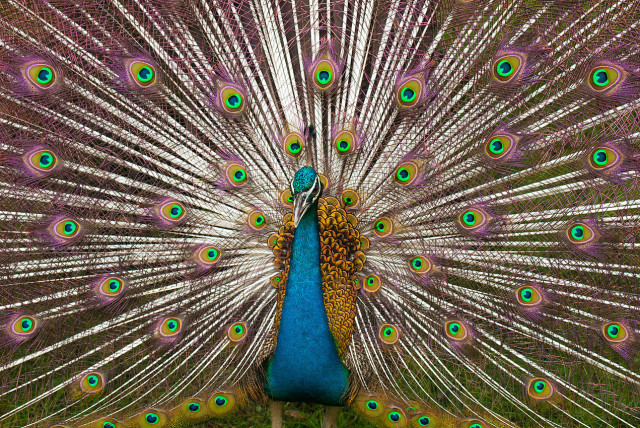Asteroid the size of 6 peacocks to fly close to Earth on Thursday - NASA

Asteroid 2024 DW is the size of around six adult Indian peacocks and will fly within the Moon's orbit of the Earth on February 22, according to NASA.
An asteroid the size of over six adult Indian peacocks is set to pass close to the Earth on Thursday, February 22, according to NASA's asteroid tracker.
The asteroid in question has been designated 2024 DW, according to the Center for Near-Earth Object Studies (CNEOS) at NASA's Jet Propulsion Laboratory (JPL).
According to estimates, the asteroid is just one of several that will pass the planet on February 22, though it will be flying much closer than the others.
Streaming service news? How big is the asteroid coming toward Earth in 2024?
Though estimates range between 10 meters and 23 meters in diameter, NASA's Eyes on Asteroids tool put 2024 DW's measurements at around 13.8 meters wide.
To put use a more familiar animal metric, let's compare it to the not-so-humble peacock.
No, this is not a reference to NBC's Peacock streaming service, which would be a very inappropriate comparison since this asteroid is going to fly harmlessly past the Earth while Peacock is home to a number of hits, that is to say hit shows and movies, though it also has plenty of misses.
No, this refers to the Indian peacock - or more accurately, the peafowl. Yes, everyone has gotten the name of this species wrong. Peacocks are the males of the species, the females being peahens.
But this article specifically referred to peacocks because male peacocks are much larger. How much? Well, when taking into account their immense colorful tail, peacocks can be as much as 2.2 meters long, with 1.5 meters being the tail alone.
Taking that into account, asteroid 2024 DW is around the size of over six adult male peacocks.
Of course, the asteroid is likely far heavier, and in terms of speed, it is certainly flying much faster than a peacock - yes, peacocks can fly.
I wanna see your asteroid: What other asteroids are set to pass Earth?
A number of other asteroids will be following 2024 DW as it flies past the Earth on Thursday. Here's a look at them, with their own metrics.
- 2024 CE8, a diameter of up to 47 meters, or almost 11 Mako sharks
- 2024 DX, a diameter of up to 21 meters, or over 137 pineapples
- 2024 DJ1, a diameter of up to 59 meters, or over over 151 Sony PlayStation 5 video game consoles
Don't ruffle your feathers: Will an asteroid hit the Earth in 2024?
First thing's first, an asteroid has already hit the Earth in 2024. Earlier in the year, one such asteroid the size of two ducks impacted over Germany, burning up into a harmless fireball.
That tends to be the fate of most asteroids that hit the Earth; they are small, so they burn up in the atmosphere.
Out of all the asteroids passing the Earth on February 22, 2024 DJ1 is most likely the largest and can do the most damage. However, its damage would still be far short of catastrophic.
Not only that, but its orbital path puts it far from Earth. Asteroid 2024 DW, however, will be flying much closer, with estimates saying its path will take it around 224,000 kilometers away from the Earth. While that still seems far, it's incredibly close on a cosmic scale, with the Moon being 387,000 kilometers way from Earth.
However, while NASA has indicated that an asteroid like this coming so close is a bit rarer than normal (around once a month at best, out of the dozens that pass by each month), it still won't be hitting us.
Just winging it? How can we stop an asteroid from hitting the Earth?
Scientists in the field of planetary defense have been working hard at trying to stop an asteroid impact, as seen under the umbrella of the Asteroid Impact Deflection Assessment (AIDA) mission.
Of the projects under this banner, success has already been made with NASA's Double Asteroid Redirection Test (DART) mission, which managed to impact the faraway asteroid Dimorphous and alter its orbit.
With enough time in advance, scientists can do that again. Which is why the most important step in planetary defense is keeping an eye on all incoming asteroids.
So don't get too distracted by watching peacocks, or by watching shows on Peacock.
Jerusalem Post Store
`; document.getElementById("linkPremium").innerHTML = cont; var divWithLink = document.getElementById("premium-link"); if (divWithLink !== null && divWithLink !== 'undefined') { divWithLink.style.border = "solid 1px #cb0f3e"; divWithLink.style.textAlign = "center"; divWithLink.style.marginBottom = "15px"; divWithLink.style.marginTop = "15px"; divWithLink.style.width = "100%"; divWithLink.style.backgroundColor = "#122952"; divWithLink.style.color = "#ffffff"; divWithLink.style.lineHeight = "1.5"; } } (function (v, i) { });

